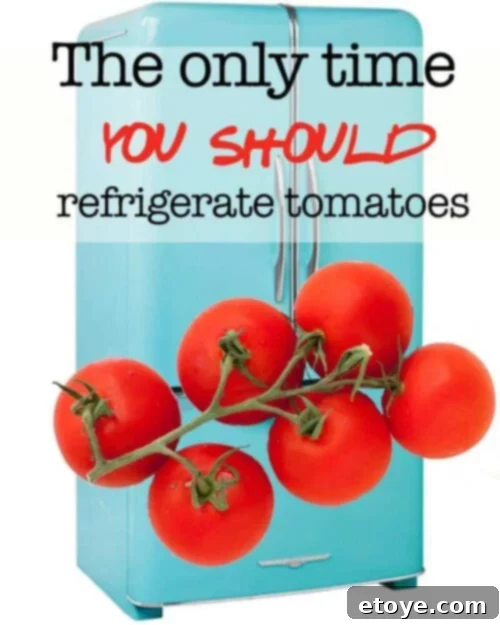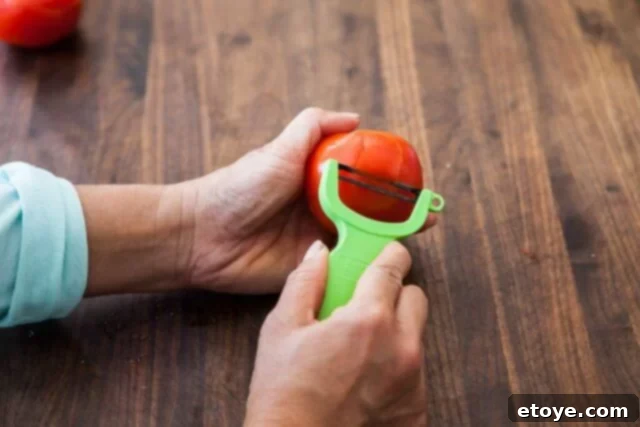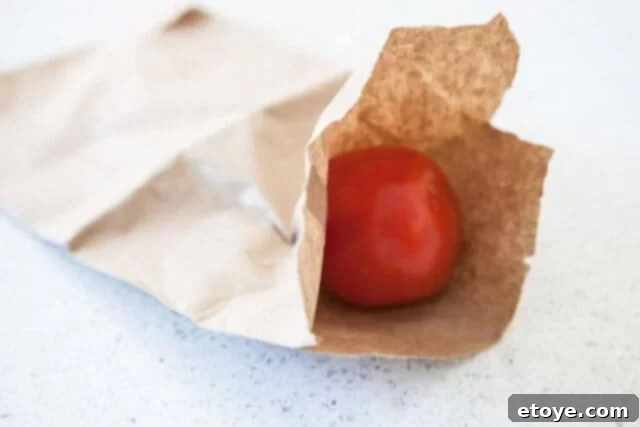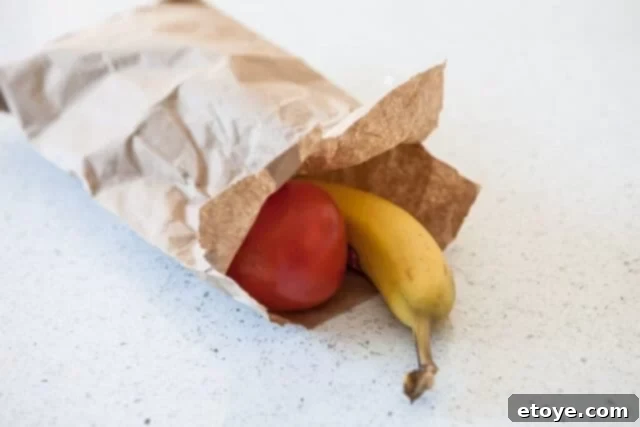
Mastering Tomato Storage: Keep Your Tomatoes Fresh, Flavorful, and Firm
Tomatoes are a culinary staple, cherished for their vibrant color, tangy sweetness, and versatility in countless dishes. From a simple Caprese salad to a rich pasta sauce, their quality significantly impacts the final taste. Yet, one of the most common kitchen dilemmas revolves around their storage: should you refrigerate tomatoes or leave them on the counter? The answer isn’t as straightforward as you might think, and understanding the science behind proper tomato care can unlock their full flavor potential.
During my time living in sunny Florida, I had the unique opportunity to reside near a bustling tomato farm and a massive packing and distribution facility. Witnessing millions of tomatoes being harvested, processed, and shipped across the United States each week offered invaluable insight into their journey. These tomatoes were typically picked when rock hard and unripe, a necessary measure to protect them from the rigors of conveyor belts, washing machines, truck transport, and extensive handling before they even reach your local supermarket shelf. This robust journey is crucial for commercial distribution, but it also means that the tomatoes arriving in your kitchen are often not at their peak ripeness or flavor.
Once these supermarket tomatoes, or even vine-ripened beauties from a farmer’s market, make it into your home, the question shifts: what’s the absolute best way to store them to ensure maximum flavor, optimal texture, and to prevent premature spoilage? The good news is that scientific research provides clear guidelines, dispelling common myths and offering practical solutions for every type of tomato you bring home.
The Science of Storing Tomatoes: Why Refrigeration Often Fails the Flavor Test

The prevailing advice from horticultural scientists and research centers is clear: avoid refrigerating tomatoes, especially those that are not fully ripe. Extensive studies, including those conducted by the University of Florida’s Horticultural Sciences Department, pinpoint the ideal temperature range for ripening tomatoes between 65°F (18°C) and 75°F (24°C).
Temperatures colder than 55°F (13°C), typically found in household refrigerators (which often operate between 34°F-38°F or 1°C-3°C), can cause significant detrimental effects. This phenomenon is known as “chilling injury.” When tomatoes are exposed to these cold temperatures, particularly when unripe or even commercially ripe, they experience a loss of volatile aromatic compounds. These are the intricate chemical components responsible for the distinctive, complex flavor and fragrant aroma that makes a tomato so enjoyable.
The consequences of chilling injury are multifaceted and noticeably diminish the quality of your tomatoes. You might observe:
- Loss of Flavor: The most significant impact, as essential aroma compounds are suppressed or permanently altered.
- Mealiness: The texture becomes soft, mushy, and gritty rather than juicy and firm.
- Loss of Firmness: The structural integrity of the tomato tissue degrades.
- Pitting and Uneven Ripening: Visible surface damage and inconsistent color development, especially in greenish or partially ripe tomatoes.
- Decay: Chilling injury can make tomatoes more susceptible to microbial spoilage and rot.
Most of this damage becomes evident after about four days in a standard refrigerator. While some research suggests that *some*, but not all, flavor compounds can return if refrigerated tomatoes are allowed to warm up at room temperature, the initial damage is often irreversible. The best practice is to prevent chilling injury from occurring in the first place, thereby preserving the tomato’s natural deliciousness.
The Exception to the Rule: When Refrigeration Is Your Friend

While the scientific consensus generally advises against refrigerating commercially harvested, unripe tomatoes, there’s a crucial exception to consider: exceptionally fresh, fully ripe tomatoes. What about those glorious tomatoes picked directly off the vine, bursting with color and fragrance, or purchased at the peak of ripeness from your local farmer’s market?
If you plan to enjoy these perfectly ripe tomatoes within a day or two, your countertop, uncovered, remains the ideal storage spot. This allows them to maintain their vibrant flavor and optimal texture. However, if your perfectly ripe tomatoes are destined to sit longer than two days, refrigeration becomes a pragmatic choice. At this stage, the primary goal shifts from optimizing flavor to simply preventing spoilage. A slightly compromised but still edible tomato is always preferable to one that has turned rotten or moldy. Refrigeration, in this scenario, will effectively slow down the natural decay process.
A notable study conducted by the team at Serious Eats explored this nuance. They tested fresh, vine-ripened tomatoes from a farmer against the effects of refrigeration. Their findings indicated that high-quality, fully ripe tomatoes fared quite well in the refrigerator, maintaining much of their desirable attributes. It’s critical to note the distinction: this research focused on tomatoes that were already at their peak of ripeness, unlike the commercially picked, often unripe, supermarket varieties that are most susceptible to chilling injury.
Best Practices for Refrigerating Ripe Tomatoes
If you decide to refrigerate your ripe tomatoes for extended storage, follow these steps to minimize potential flavor and texture degradation:
- Remove from Plastic Bags: Plastic bags trap excessive moisture, creating an environment ripe for mold growth. Always take tomatoes out of any plastic packaging.
- Use a Paper Bag: Place the tomatoes in a brown paper bag. The paper allows for adequate air circulation while absorbing some excess moisture, creating a more balanced microclimate around the tomatoes.
- Crisper Drawer Placement: Store the paper bag in your refrigerator’s crisper drawer, ideally set to a higher humidity setting. The crisper drawer offers a slightly less harsh cold environment and helps manage moisture levels.
The “Better” Refrigerator for Tomatoes: A Wine Cooler

For those truly dedicated to optimal tomato preservation, particularly if you have an abundance of ripe tomatoes, a wine refrigerator can be an unexpected hero. Set at approximately 65°F (18°C), a wine cooler provides a storage environment that is perfectly cool enough for red wines and, crucially, warm enough to prevent chilling injury in tomatoes. This temperature falls squarely within the scientifically recommended range for ideal tomato storage, making it a superior option compared to a standard kitchen refrigerator, which typically runs much colder (34°F-38°F or 1°C-3°C).
Effortless Tomato Peeling: A 15-Second Secret
Peeling tomatoes is often seen as a tedious, messy task, especially when recipes call for blanched, skinless tomatoes for sauces or purees. The traditional method involves boiling water, an ice bath, and multiple steps:
- Heating a large pot of water to a rolling boil.
- Carefully submerging tomatoes into the boiling water for a short time.
- Immediately transferring them to an ice bath to stop the cooking process.
- Removing the tomatoes and then painstakingly peeling off the loosened skin.
This process not only takes considerable time and energy but also creates more dishes to wash. Forget the fuss and embrace a simpler, more efficient approach: your trusty vegetable peeler.
You don’t need a specialized serrated peeler; a standard, sharp vegetable peeler will do the trick. Gently hold the tomato in your palm. With quick, short, zigzag motions, move the peeler back and forth over the skin. Think of it like coloring with a crayon or shading with the side of a pencil – small, swift movements are key. The peeler will effortlessly glide beneath the skin, removing it in thin strips with minimal loss of flesh.


This method is incredibly fast, clean, and requires no special equipment or heat. For those looking for peeler recommendations, two stand out: the OXO Good Grips Swivel Peeler, known for its comfortable handle and dishwasher-safe design, and the Kuhn Rikon Original Swiss Peeler, which is remarkably inexpensive and boasts an exceptionally sharp blade. While the Kuhn Rikon requires a quick hand rinse and immediate drying to prevent rust and maintain sharpness, its performance and value make it a favorite for many home cooks. You can often find a pack of three for less than $10, making it an indispensable kitchen tool.
Accelerating Ripening: The Paper Bag Method
If you find yourself with a batch of underripe, firm tomatoes and can’t wait for them to naturally mature, there’s a simple, effective method to hasten their ripening process. Contrary to popular belief, direct sunlight isn’t strictly necessary for ripening tomatoes; the crucial factors are controlled humidity and temperature.
The best way to ripen tomatoes is by placing them in a brown paper bag. Set the bag in the warmest spot in your house, perhaps a sunny windowsill (though direct sun isn’t the primary driver). The paper bag acts like a mini-greenhouse: it allows just enough air circulation, maintains the right humidity level, and effectively traps heat. This creates an optimal microenvironment that encourages the tomatoes to ripen naturally and evenly, as highlighted by agricultural research centers like Planet Natural.

Avoid using plastic bags for ripening, as they trap too much humidity, which can lead to mold development rather than healthy ripening. Similarly, simply leaving tomatoes on the counter exposed to open air won’t provide the consistent humidity and warmth needed for efficient ripening.
For an even faster ripening process, consider adding an apple or banana to the paper bag alongside your tomatoes. As these fruits ripen, they naturally emit ethylene gas, a powerful plant hormone that stimulates and accelerates the ripening of other produce, including tomatoes. This simple trick can shave days off the ripening time, allowing you to enjoy your tomatoes sooner.

Preserving Tomatoes: Freezing for Future Use
While fresh tomatoes are always ideal, freezing offers an excellent solution for preserving an abundant harvest or preventing spoilage. It’s important to note that frozen and then defrosted tomatoes will inevitably become soft and mushy due to the ice crystal formation during freezing, which breaks down cell walls. However, this altered texture makes them perfectly suited for cooked applications like sauces, purees, soups, and stews where their firmness isn’t a factor.
The optimal way to freeze tomatoes is to first prepare them. Begin by peeling them using the quick vegetable peeler trick mentioned earlier – no boiling water needed! Once peeled, roughly chop the tomatoes into manageable pieces. Then, transfer them into freezer-safe bags or containers. To prevent freezer burn and maximize quality, remove as much air as possible from the bags before sealing. You can also freeze whole, peeled tomatoes, or even blend them into a puree before freezing for convenience in future cooking projects.
Transforming Flavor: The Magic of Tomato Powder
For a truly versatile and flavor-packed ingredient, consider making tomato powder. If you own a dehydrator, this process is straightforward and incredibly rewarding. Start by slicing your tomatoes (peeling is optional for powder, but removes some bitterness from skins). Arrange them on dehydrator trays and dry them until they are completely brittle. To prepare them for pulverizing, freeze the dried tomato slices for a couple of hours. This step makes them even more brittle, ensuring they process into a fine, consistent powder.
Once frozen, transfer the dehydrated tomatoes to a food processor or high-speed blender and process until you achieve a fine, uniform powder. Store this “tomato spice” in an airtight jar in a dark, cool spot, and it will retain its potency for 1-2 years.
Tomato powder is a phenomenal, all-natural, and vegan “umami” flavor enhancer. Ripe tomatoes naturally contain high concentrations of glutamate, the compound responsible for umami, the savory fifth taste. Drying them intensely concentrates these glutamates, resulting in a rich, complex, savory-sweet flavor that can elevate almost any dish. It adds depth without adding liquid, making it a secret weapon in your pantry. A little water mixed with tomato powder instantly creates tomato paste, and a bit more water yields a quick tomato sauce.
If making your own isn’t feasible, high-quality tomato powder is readily available for purchase for just a few dollars, offering a convenient way to enjoy its benefits.
Versatile Ways to Use Powdered Tomato
- Stir into scrambled eggs for a burst of savory flavor.
- Sprinkle generously on ground meat mixtures for burgers, meatballs, or meatloaf.
- Combine with dried shiitake powder and rub onto steaks before grilling.
- Add to any marinade, especially for vegetables destined for the grill or oven.
- Enhance the depth and richness of soups and stews.
- Season chicken before roasting or grilling, or toss with roasted potatoes.
- Intensify the flavor of your spaghetti sauce or chili without watering it down.
- Blend into smoothies for a subtle, earthy undertone and added nutrients.
- Use as a seasoning for popcorn, homemade chips, or roasted nuts.
Conclusion: The Art and Science of Enjoying Tomatoes
Understanding how to properly store, ripen, and even preserve tomatoes is key to truly appreciating this versatile fruit. By heeding scientific advice, we can ensure our tomatoes deliver their best flavor, texture, and nutritional value. Remember, generally keep unripe and supermarket tomatoes out of the fridge to protect their delicate aroma compounds. For truly ripe tomatoes, a short stint in the crisper drawer can extend their life, provided you use proper techniques. Embrace the efficiency of a vegetable peeler, harness the power of a paper bag for ripening, and explore the incredible depth of flavor offered by homemade or store-bought tomato powder. With these tips, every tomato you encounter can be transformed from a simple ingredient into a culinary highlight.
References
University of Florida Klee Lab Research
Proceedings of the National Academy of Sciences of United States of America
University of Florida Horticultural Sciences Department, November 2011 Issue No. 568
On Food and Cooking, Harold McGee
The Cooks Illustrated Cookbook, page 14
Serious Eats
Molecular Recipes – Umami – the Delicious 5th Taste
United States Department of Agriculture
Effects of chilling on tomato fruit texture by Robert Jackman, Henry Gibson, David Stanley
